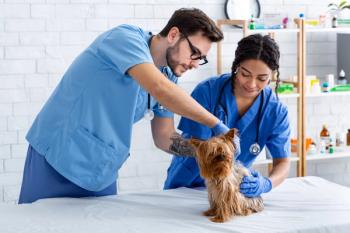
Oil spill: Top 4 health threats to pets
Oil from the Gulf spill threatens pets. Here's what veterinary team members need to know about the top dangers.
BP has capped the flow of oil coming from its Deepwater Horizon offshore drilling rig. However, after the leak persisted for almost three months, millions of gallons of oil have contaminated the waters and still threaten coastal areas. The toxic properties of oil pose health risks for wildlife-and even dogs and cats. Here's what veterinary team members need to know about the top dangers.
Threat 1: Skin contact
When crude oil contacts an animal's skin, it may cause a variety of deleterious effects depending on the species:
• Prolonged dermal exposure in any species may result in red, irritated, and swollen skin with the possibility of infection and necrosis (skin death).
• Animals with thick or long hair may be more severely affected by skin contact with oil, because the oil can become trapped next to the skin.
• Birds are particularly vulnerable to oil saturation. Oil disrupts the interlocking effect of their feathers and may render birds unable to fly, float, or maintain a normal body temperature. Therefore, they may not be able to escape from predators, care for their young, or find enough food to survive.
• Hoofed animals, such as cattle, can develop laminitis after walking in soil contaminated with crude oil, which is absorbed through the hoof wall and could cause inflammation.
Threat 2:
Threat 2: Ingestion
Crude oil on the skin often leads to ingestion, especially in animals that are prolific groomers, such as birds and cats. Ingestion of petroleum-based products may cause the following:
• Irritation to the mouth, which can cause drooling, constant licking, shaking of the head, and pawing at the mouth
• Gastrointestinal (GI) irritation such as vomiting, diarrhea, and abdominal pain (Note that vomiting is the most common cause of oil aspiration into the lungs.)
• More serious GI effects such as stomach or intestinal ulceration
• Signs similar to those of alcohol intoxication, including drowsiness, ataxia (incoordination), confusion, vertigo, tremors, and seizures
• Cardiovascular problems such as an irregular heartbeat or even cardiovascular collapse
• In rare cases, ingestion of large amounts can result in hemolytic anemia, liver and kidney damage, coma, and sudden death.
Confirming the ingestion of oil or any hydrocarbon can be challenging because various toxins and infectious diseases may produce the same clinical signs. One easy in-house diagnostic test that can help is obtaining a sample of the animal's vomitus or stomach contents and mixing the sample vigorously with warm water to see if any hydrocarbon rises to the surface.
Threat 3:
Threat 3: Aspiration
Crude oil has a low viscosity, meaning that it is relatively fluid rather than being sticky or thick. Therefore, it is easily aspirated (inhaled) into the lungs, where it spreads quickly. If aspirated oil enters the lungs' small airways, it may cause chemical pneumonitis or aspiration pneumonia, one of the most life-threatening complications of oil contact. Watch for these signs and complications of oil aspiration:
• The most common signs of aspiration include choking, coughing, gagging, and difficulty breathing.
• Within one hour of exposure, there can be swelling, bronchospasms, bleeding into the airways, and death of the terminal airways and alveoli (small air sacs).
• Abnormalities visible on radiographs may proceed or follow the clinical respiratory signs; typically, radiographic changes are visible within a few hours of aspiration.
• Depending on how much oil was aspirated, animals may become cyanotic (“blue”) as the lungs fail to oxygenate the body.
• Animals may develop a fever three to four hours after aspiration, although a fever may be delayed up to 24 hours.
Threat 4:
4. Contact with dispersants
During the cleanup efforts, workers are using chemical dispersants in an effort to break the oil into smaller droplets, which helps prevent the formation of larger oil slicks and oil from sticking to animals and vegetation. If animals come into contact with these dispersants, a variety of signs and complications may occur:
• Contact with the skin or eyes may cause irritation.
• Inhalation may cause respiratory irritation and inflammation.
• Ingestion may cause GI irritation such as vomiting.
• Depending on the type of dispersant used, repeated or excessive exposure may dam-age the red blood cells, kidneys, and liver.
Helping affected animals
There are multiple resources available for consultation regarding animals exposed to oil from the Gulf spill. For veterinarians and team members needing assistance with a companion animal exposed to oil from this disaster, Pet Poison Helpline is providing free consultations. Pet Poison Helpline is available 24 hours a day, seven days a week and can be reached at (800) 213-6680.
About Pet Poison Helpline
Elizabeth Greenlee, CVT, EMT, is a veterinary technician with
Newsletter
From exam room tips to practice management insights, get trusted veterinary news delivered straight to your inbox—subscribe to dvm360.






